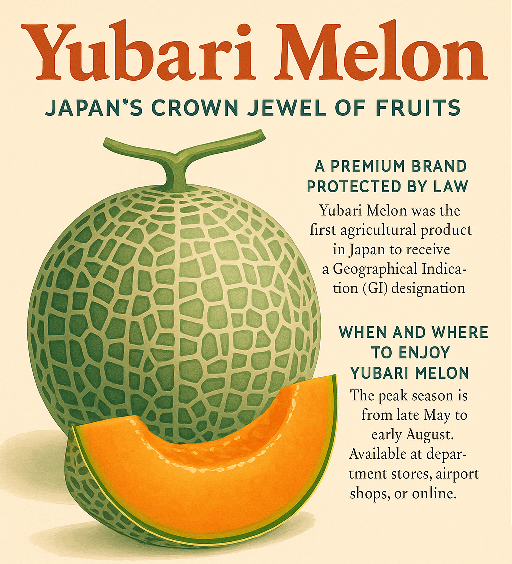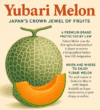
When it comes to Japanese luxury fruits, few names shine as brightly as the Yubari Melon. Grown exclusively in Yubari, Hokkaido, this stunning, perfectly round melon with its smooth, netted skin and deep orange flesh is far more than just a sweet treat — it’s a symbol of Japanese agricultural craftsmanship and prestige.
What Makes Yubari Melon So Special?
The Yubari Melon is a hybrid of two cantaloupe varieties, cultivated in carefully controlled greenhouse environments. The result is a fruit with an exceptionally high sugar content, juicy texture, and an aroma that is both sweet and floral — a far cry from the more subtle taste of typical Western cantaloupes or honeydews.
Each melon is meticulously hand-pollinated, and farmers often grow only one or two fruits per vine to maximize flavor. The result? A dessert-like fruit so rich and fragrant that it is often enjoyed chilled and sliced, without any need for additional toppings.
A Premium Brand Protected by Law
Yubari Melon was the first agricultural product in Japan to receive the Geographical Indication (GI) designation, a mark that ensures only melons grown under strict conditions in Yubari can bear the name. This legal protection preserves the melon’s authenticity and exclusivity, much like Champagne in France or Parmigiano-Reggiano in Italy.
When and Where to Enjoy Yubari Melon
The peak season for Yubari Melon is from late May to early August. During this time, you can find them at high-end department stores in Japan such as Mitsukoshi or Isetan, at airport gift shops in Hokkaido, or even online through official agricultural cooperatives.
Internationally, limited quantities are occasionally exported to major cities in Asia, such as Hong Kong or Singapore, but they remain a rare find — and a true collector’s delicacy.
Luxury With a Price Tag
One of the reasons Yubari Melon gained international fame was due to record-breaking auction prices. In 2019, a pair of Yubari Melons sold for 5 million yen (approximately $45,000 USD) at a seasonal auction. While regular melons are far more affordable (typically around $50–$200 USD each), the aura of elegance, rarity, and gifting culture still surrounds them.
In Japan, it’s common to give premium fruits like Yubari Melon as “ochūgen” (mid-summer gifts), a tradition that values the act of giving seasonal delicacies as a symbol of respect and care.
How Does It Compare to Other Melons?
While cantaloupes in the U.S. or Europe tend to have rougher skins and milder sweetness, Yubari Melon delivers an intensely sweet, melt-in-your-mouth experience with a balanced acidity that enhances its flavor. Its vibrant orange flesh is more visually striking than most Western melons, and the refined appearance and packaging — often in velvet-lined boxes — elevates it to a level rarely seen elsewhere.
Final Thoughts
The Yubari Melon is more than just fruit; it’s a cultural artifact, a statement of craftsmanship, and a luxurious indulgence. For anyone visiting Japan — especially during the summer — seeking out and tasting an authentic Yubari Melon is a truly unforgettable gastronomic and cultural experience.
So next time you’re in Japan, treat yourself. You’re not just buying a melon — you’re savoring a piece of Japanese perfection.
夕張メロン:日本の果物の宝石
日本の高級フルーツの中で、夕張メロンほど輝く名前はそう多くありません。北海道夕張市でのみ栽培されるこの見事で、完全な球体をしたメロンは、滑らかな網目模様の皮と深いオレンジ色の果肉を持ち、単なる甘いおやつ以上の存在です。これは日本の農業技術と名声の象徴です。
夕張メロンはなぜ特別なのか?
夕張メロンは、2種類のカンタロープ(マスクメロン)の交配種であり、厳密に管理された温室環境で栽培されます。その結果、非常に高い糖度、ジューシーな食感、甘くてフローラルな香りを持つ果物が生まれます——風味が控えめな欧米のカンタロープやハニーデューメロンとは大きく異なります。
すべての果実は丁寧に手作業で受粉され、農家は1本のツルに1〜2個の果実しか育てません。それにより、まるでデザートのように濃厚で芳醇な果物が生まれ、冷やしてスライスするだけで十分に楽しめます。
法的に守られた高級ブランド
夕張メロンは、日本で初めて地理的表示(GI)保護制度の認定を受けた農産物です。この制度により、夕張で特定の条件下で栽培されたメロンのみが「夕張メロン」と名乗ることができます。この法的保護により、シャンパーニュ(フランス)やパルミジャーノ・レッジャーノ(イタリア)のように、本物と希少性が守られています。
夕張メロンを楽しむ時期と場所
夕張メロンの旬は、5月下旬から8月上旬です。この時期には、日本国内の三越や伊勢丹などの高級百貨店、北海道の空港のギフトショップ、または農協の公式オンラインストアなどで購入することができます。
海外では、アジアの主要都市(たとえば香港やシンガポール)に限定的に輸出されることがありますが、依然として非常に珍しく、コレクターズ・アイテムのような果物です。
価格のついた贅沢品
夕張メロンが国際的に有名になった理由の一つは、記録的な競り落とし価格にあります。2019年には、1対の夕張メロンが500万円(約45,000米ドル)で落札されました。通常の夕張メロンはもっと手頃(1玉あたり5,000〜20,000円程度)ですが、エレガントさ、希少性、贈答文化の象徴としての価値は依然として高いままです。
日本では、夕張メロンのような高級フルーツを「お中元(夏の贈り物)」として贈ることが一般的で、季節の恵みを贈るという敬意と気遣いの象徴となっています。
他のメロンとどう違うのか?
アメリカやヨーロッパのカンタロープは皮がゴツゴツしていて甘さが控えめなのに対し、夕張メロンはとても甘く、口の中でとろけるような味わいを持ち、ほのかな酸味がその味を引き立てます。鮮やかなオレンジ色の果肉は見た目にも美しく、ビロードの内張りがついた箱に丁寧に梱包されるなど、海外では見られないような高級感があります。
まとめ
夕張メロンは、単なる果物ではありません。それは文化的遺産であり、職人技の結晶であり、贅沢な楽しみです。日本を訪れる人にとって、特に夏の季節に本物の夕張メロンを味わうことは、忘れがたい食の体験であり、文化との出会いでもあります。
次に日本に来たときは、ぜひ自分にご褒美を。あなたが手にするのは、ただのメロンではなく、日本の完璧さを味わうひとときです。
